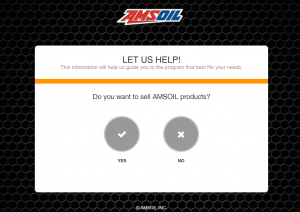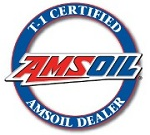AMSOIL manufactures top quality synthetic lubricants for many applications besides automotive. Understand that bearings, gears and cylinders need different formulated products.
THERE’S A LUBE FOR THAT BEARINGS, GEARS, CYLINDERS – WE’RE TALKING INDUSTRIAL LUBRICANTS!
Regardless of equipment type, there are generally three basic types of components that require lubrication: bearings, gears and cylinders. Nearly all equipment and components fall under one of those three categories.
Bearings
Bearings allow a surface to rotate or slide when under load. The word “bearing” means to bear or support (in this case a shaft or surface). Bearings are categorized into two types: plain bearings and rolling-element bearings. Plain bearings, such as sliding, journal, sleeve or bushing bearings, are generally softer than the shaft or surface being supported. This protects the shaft at the expense of the bearing. Softer bearing materials have a tendency to collect debris that the lubricant must overcome.
Plain bearings function best under hydrodynamic lubrication (full-film) or boundary (thin-film) lubrication. Oils and greases are typically used to lubricate these types of bearings. Rolling-element bearings, also referred to as anti-friction bearings, are a class of bearings where elements such as balls, rollers or needles keep a moving surface separate from a stationary surface. They are generally referred to by the shape of the rolling elements they contain: ball bearing, roller bearing, needle bearing or tapered-roller bearing. These types of bearings commonly function under elastohydrodynamic lubrication. When lubricated properly, the load capacity and life of such bearings is limited primarily by the strength of the bearing steel. Oils or greases typically lubricate these types of bearings.
Typical materials used in the construction of modern bearings are bronze, lead, copper, aluminum, nylon and plastic. Older bearings containing alloys of tin, copper and antimony are called babbit, soft or white-metal bearings.
Gears
Gears are used to transfer power or motion from the power source to the application. They are also used to change the direction, speed or rotational force (torque) of that motion.Gears come in many configurations that have different lubrication requirements depending on their intended application. Gears are most often lubricated with oils; however, thin greases (a mixture of oil and a thickener) may also be used.
Spur, Helical and Herringbone Gears
Spur, helical and herringbone gears are typically lubricated using what are commonly referred to as rust and oxidation (R&O) oils. R&O fluids are base oils with rust and oxidation inhibitors. Depending on the application, a mild extreme-pressure (EP) additive may be required.
Hypoid Gear
Hypoid gear sets are typically used in automotive components such as differentials. Sliding pressures and shock-loading require the use of high levels of EP additives (API GL-4 or GL-5 performance level). Generally, a fluid’s API number roughly estimates its concentration of EP additives.
Bevel Gear
Bevel gear sets also require the use of EP additives; however, the level is less than the level required for hypoid gears.
Careful consideration of how a lubricant is to be applied provides insight as to what properties, such as viscosity and clinging tenacity, may be required.
Worm Gear
Worm gears typically use high-viscosity oils containing friction modifiers and very low EP additive levels. Because these gears may be brass or bronze material, EP additives should be avoided to prevent corrosion. Many applications use a combination of gear types. The lubricant meeting the requirements of the most demanding gear will be the determining factor in deciding which lubricant to use.
Cylinders
Cylinders typically require minimal amounts of lubrication. Higher viscosity R&O fluids generally meet a cylinder’s requirements. In cases where sliding loads are high (two-stroke gasoline engines), friction modifiers may be necessary. Apply ‘The Right Principle’ When determining the proper lubricant for an application, the key is the ability to satisfy all equipment needs, such as compatibility with a particular method of supplying or applying the lubricant.
Some modern methods include any combination of the following techniques: pouring, dripping, wicking, immersion, brushing, spraying, pumping and impregnation.
Other factors include how, where and when the system is being used. The composition of the material used within the system can also dictate lubrication requirements. A seal or copper component, for example, might require specific lubrication treatments to avoid damage.
When determining the proper lubricant for an application, the key is the ability to satisfy all equipment needs, such as compatibility with a particular method of supplying or applying the lubricant.
Careful consideration of how a lubricant is to be applied provides insight as to what properties, such as viscosity and clinging tenacity, may be required. Thinking about the possibilities should always lead to applying the Right Principle, which is using the right lubricant, in the right place, at the right time.
Have an industrial lubricant question? Get in touch with us to learn more about AMSOIL industrial products. Some of the products are not offered on the AMSOIL website. The reason is many dealers do not have the training or expertise on recommending industrial products. We are veteran AMSOIL Dealers and have had numerous trainings on all types of applications for products.
Some products available but not listed on the AMSOIL Online Store.
- SG Series Synthetic Extreme-Pressure Gear Oil
- PT Series Synthetic Power Transmission EP Gear Lubes
- Multi-Viscosity Ashless Hydraulic Oil
- Synthetic AW Series Anti-Wear Hydraulic Oils
- Industrial Grade Synthetic Compressor Oils
- RC Series R&O/AW Synthetic Gear and Bearing Oil
- Bearing & Chassis Greases
Commercial and Industrial companies can purchase AMSOIL products with a Factory Direct Commercial Account.
Get in touch with us if you have any questions about products or to setup an AMSOIL Account.




